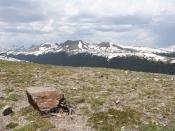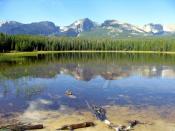Many climbers want one pack to meet all their needs - whether they're high above the clouds on some obscure peak or 20 feet above their last piece on a sun-drenched expanse of alpine granite. Unless you're a dedicated burlmeister or a die-hard masochist, however, expedition packs are too big for your everyday forays. The beefy suspension systems will be cumbersome for summer backpacking, and the extra space will seem like overkill on day trips to the crags. But when you find yourself heading into thin air, or any other situation where you will be punishing yourself with a heavy load, these collosal packs will ease the pain.
For the sake of the review , I narrowed the field of 40-some manufacturers and scores of large internal-frame packs down to 10 companies' products, choosing the broadest possible range of design approaches and features. The selected packs all measure 5,500 cubic inches in volume (90 liters) or more.
And the packs are intended for climbers; they have essential features, such as loops for ice tools, reinforced swatches for strapping on crampons and large grab loops on zippers for easy access even with gloves.
To test the packs, I schlepped heavy load after heavy load into Rocky Mountain National Park and the surrounding mountains over the course of a month. I carried each of the packs on multiple occasions, each time loading the chosen pack with 70 pounds of ballast - that is, lots of cams, iron and ropes. Because all the packs carried well enough - some better than others - the hardest part was often mustering up the strength to keep staggering along the trail under such hes. By month's end, my back ached, my quads screamed and my body was exhausted. It was a familiar feeling - kind of like the one I have at the finish of a long day on any expedition.
frames All expedition pack manufacturers have the same primary goals: Distribute the pack's weight to the hips and keep the weight close to the body's center of balance without sacrificing support, or adding too much weight or price. Since the advent of the original Lowe Alpine expedition pack, the first two-stay, internal frame pack, pack design hasn't varied much. Many bags use aluminum stays (Lowe Alpine, Gregory, Kelty and others) because they are light, inexpensive and can be adjusted to fit the user. For extra support in expediton-sized packs, some manufacturers use stiffer materials: Dana Design uses carbon fiber rods; Vortex uses injection-molded composite; and Osprey uses titanium ReCurve Struts. Both Madden and Lowe use Delrin hoops to stabilize the pack and transfer the weight to your hips. Bucking tradition, the Granite Gear Cirrus Access has no stays; instead, the company uses a carbon fiber frame sheet, which makes for a stiffer frame. But you're stuck with the shape because the sheet can't be customized to fit your back.
fabrics Until recently, pack manufacturers boasted durable Cordura materials that they used in their products. Today, however, Cordura has fallen by the wayside as many companies are weaving amazingly strong, durable and lightweight new fabrics. No longer do you have to sacrifice suppleness for a waterproof pack or weight for strength. Kelty, for example, uses Spectra fabric and a Kevlar-like thread - a unique combination that's both amazingly strong (10 times stronger than steel) and light. Mystery Ranch's Wild Weave Cordura and Granite Gear's VX-21 use more typical fibers, but the advanced weaving techniques make for stronger, more durable results than in the past. Direct comparisons are difficult, however, as manufacturers stamp proprietary names on fabrics with few differences.
durability If you want to gauge a pack's durability, the construction (both patterning and sewing) may be a bigger concern than whether it's made from Super-Cloth or Miracle-Material. For example, though Gregory says its Shelter-rite-reinforced bottom increases the pack's overall durability, the feature's real utility is to protect your bag from its own frame sheet, which otherwise presses sharply against the bottom. Dana, on the other hand, has improved the durability of its pack by having the sleeping bag compartment "differentially cut." In other words, they have sewn in a smaller liner to keep the contents from pressing on the exterior fabric, which prevents excessive abrasion.
features Important features, such as extra-long compression straps for lashing, may go unnoticed when you try on a pack in a store, while non-essential items, such as zip-off day packs that add unnecessary weight, steal your attention. On the other hand, a few extra touches can make life on the trail more convenient (see "Creature Features," p.98).
weight The packs in this review range from a skimpy 4.7 pounds to a beefy 8.5 pounds. Keep in mind, however, pack weight is a small fraction of the total load you'll shoulder. Shell jackets, utensils, toothbrushes - they all add up. Ultra-light packs are often ultra-expensive, but eliminating extraneous gear doesn't cost a dime.
volume Advertised pack volumes range from 90 to 122 liters (roughly 5,500 to 7,400 cu. in.), with an average of 106 liters (about 6,500 cu. in.). But numbers don't tell the whole story. While the Mystery Ranch A7000 has the biggest numeric volume, I found the cavernous Madden Mountaineer took in my testing ballast much more easily, despite having a stated volume that's 700 cubic inches smaller.
Your individual packing style will mesh with some designs better than with others. Once you've narrowed the field to just two packs, here's what to do: Put all the gear you'll be taking on your next trek into a duffel bag. At the store, load each pack. Pick the design that seems most logical, or keep looking.
price There's a $350 disparity between the most expensive pack (the Kelty Cloud 6500 at $600) and the least expensive (Lowe Alpine Alpamayo 90 at $249). Price matters, but if the pack you buy makes you miserable, you'll want to kick yourself for looking after your wallet more than your back. High-tech pack design involves years of testing, tremendous labor and specialized materials. None of those things come cheap, but invest wisely, and you'll get a nice return with every step.
fit I shouldn't have to, but I'll say it anyway: Fit is paramount! I used the manufacturers' recommended sizing to order the pack frames, hip belts and shoulder pads/harnesses. Amazingly, every pack fit at least adequately. Still, it's best to try on a pack before buying it (see "If the Pack Fits," p.100). In terms of foam for shoulder pads and hip belts, there is no universal comfort rating to compare Arc'teryx's Evazote 50 to Gregory's Flo-form II. When you try on packs, you'll find that some pads are cushy, yet not comfy, or vice versa. Other pads are firm but fit exceptionally well. In other words, the feel of particular pads depends on your geometry and your curves. Side-by-side comparisons are the best way to narrow down the field and find your ideal fit.





